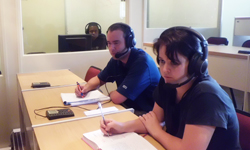Latest News Archive
Please select Category, Year, and then Month to display items
05 June 2018
Photo Supplied
 Archaeological excavations in the Wonderwerk Cave, north of Kuruman in the Northern Cape.
Archaeological excavations in the Wonderwerk Cave, north of Kuruman in the Northern Cape.
Research fellow Dr Lloyd Rossouw from the Department of Plant Sciences at the University of the Free State (UFS) recently published an article in the Nature Ecology and Evolution journal with Dr Michaela Ecker from the University of Toronto as lead author, and Dr James Brink, research fellow at the UFS Centre for Environmental Management. The findings described in “The palaeoecological context of the Oldowan-Acheulean in southern Africa” provides the first extensive paleoenvironmental sequence for the interior of southern Africa by applying a combination of methods for environmental reconstruction at Wonderwerk Cave, which have yielded multiple evidence of early human occupation dating back almost two million years ago.
Where water once was
The Wonderwerk Cave is found north of the Kuruman hills (situated in Northern Cape) a 140m long tube with a low ceiling. The surroundings are harsh. Semi-arid conditions allow for the survival of only hardy bushes, trees, and grasses. But during the Early Pleistocene, stepping out of the Wonderwerk Cave you would have been greeted by a completely different site, the researchers found. Using carbon and oxygen stable isotope analysis on the teeth of herbivores (Dr Ecker), fossil faunal abundance (Dr Brink), as well as the analysis of microscopic plant silica remains (phytoliths) excavated from fossil soils inside the cave (Dr Rossouw), the results show that ancient environments in the central interior of southern Africa were significantly wetter and housed a plant community unlike any other in the modern African savanna.
What difference does it make?
While East African research shows increasing aridity and the spread of summer-rainfall grasslands more than a million years ago, the results from this study indicate an interesting twist. During the same period, shifts in rainfall seasonality allowed for alternating summer and winter-rainfall grass occurrences coupled with prolonged wetlands, that remained major components of Early Pleistocene (more or less the period between one and two million years ago) environments in the central interior of southern Africa. That means our human ancestors were also living and evolving in environments other than the generally accepted open, arid grassland model.
“To interpret is more than the ability to have mastered two languages”
2014-03-27
|
 |
It is equally unfair to the accused as the victim when an untrained court interpreter is used in a court case.
In South Africa there are currently a large percentage of interpreters employed by the Department of Justice without any formal training.
While interpreting is in reality a very complex subject, the general acceptance is that everybody who is able speak two languages or more can be an interpreter.
This perception harms interpreting as a profession, as it results in most institutions appointing any multilingual person as an interpreter.
In many cases people are used to interpret into and from their third or fourth language (of which Afrikaans is one). This leads to inaccuracy and the incorrect use of expressions and terminology. Specific cognitive processes also have to be developed and practiced.
The University of the Free State (UFS) has since 2008 trained approximately 200 court interpreters in South Africa. This training includes the theory of interpreting and practical exercises, as well as the development of terminology and a basic knowledge of the legal system in South Africa.
The training provided to court interpreters by the Unit for Language Management and Facilitation, is done in conjunction with the Department of Justice and Constitutional Development and SASSETA (Safety and Security).
Apart from Afrikaans, native speakers of all South African languages are included in the training.
Much attention (rightfully) are given to interpreters who can interpret between the nine African languages and (mostly) English, but in the process the development of interpreters between Afrikaans and English was neglected, as became apparent in the past two weeks during the Oscar Pistorius case.